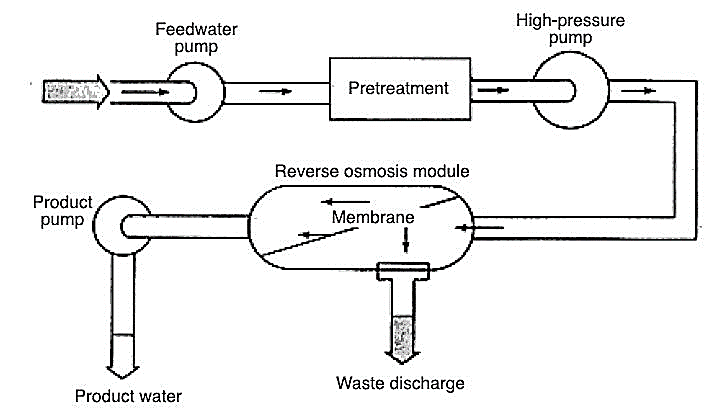
Seawater Desalination with Reverse Osmosis Plant
All Reverse Osmosis vegetation are fundamentally Desalination Crops but desalination is getting referred to sea drinking water normally.As sea drinking water has incredibly high TDS calls for pretty higher stress to pressure sea h2o through membranes that happen to be distinctive then brackish h2o membranes.
Reverse Osmosis Plant Particulars:
A reverse osmosis plant is actually a production plant, in which drinking water is purified and desalinated by forcing drinking water by way of a membrane, normally generally known as a reverse osmosis system. H2o made by plant RO can be useful for various applications like desalination, wastewater procedure, as well as reclamation of dissolved minerals.
RO Plant Description
A median drinking h2o RO plant procedure necessitates 6 KW hrs of electrical energy to desalinate a single cubic meter of water. Reverse osmosis h2o plants demands a number of pre-treatment techniques together with softening, DE chlorination, and anti-scale cure. Adhering to pre-remedy, high amounts of stress send out water via a semi-permeable membrane, which holds all contaminants apart from drinking water.
RO Plant Style
To improve the effectiveness and lifetime of the Reverse Osmosis plant, powerful pretreatment from the feed water is necessary. Collection of the right pretreatment will optimize efficiency and membrane daily life by decreasing:
Fouling
Scaling
Membrane Degradation
RO plant structure is consisting of:
Identifying pretreatment need of Reverse Osmosis Plant
In the event the feed drinking water has traces of major metals, it is highly encouraged to dose some chlorine to alter the dissolved major metals to physical sort, the media filter will filter most of it in the ro h2o purifier plant.
Reverse Osmosis Plant Selection of membrane
Membrane aspects are a very important A part of RO vegetation. The proteins (generally polyamide) that makeup membrane things change depending upon the ending clarity and intake water seawater or brackish water and so forth
Waterman engineers Australia RO plant for seawater desalination
Waterman Engineers in Australia has intended a Reverse Osmosis (RO) plant for seawater desalination, which features several benefits above other desalination approaches. Here are several essential advantages of their RO plant:
Strength Effectiveness:
When compared with other desalination tactics like thermal distillation, RO involves a lot less Electricity. Waterman Engineers' RO plant makes use of Innovative membrane technological innovation, making it possible for it to function at reduce pressures and cut down In general Electricity intake.
Environmental Effect:
RO generates much less brine discharge in comparison to thermal methods, lessening the effect on maritime ecosystems. This aligns with Australia's center on environmental sustainability and conservation.
Substantial Water Purity:
The RO method successfully gets rid of salts, minerals, and impurities, generating high-excellent freshwater that meets stringent consuming h2o expectations. This reliability is important for supplying Safe and sound and thoroughly clean drinking water to communities.
Modular Layout:
Waterman Engineers' RO plant employs a modular layout, allowing for scalability and suppleness. This is especially useful for places with various h2o demands, as modules might be included or altered accordingly.
Lowered Footprint:
RO vegetation commonly have a more compact Bodily footprint compared to thermal desalination crops, which frequently need substantial infrastructure for heating and cooling procedures.
Rapid Get started-Up and Shutdown:
RO crops can be began and stopped comparatively speedily, letting for improved responsiveness to changing h2o calls for and emergencies.
Reduced Chemical Utilization:
As opposed to Various other desalination approaches, RO requires fewer substances for Procedure and cleaning, minimizing chemical-relevant environmental fears.
Regularity in Effectiveness:
The RO course of action is much less sensitive to feedwater high-quality fluctuations than other solutions, guaranteeing a more consistent performance eventually.
Charge-Efficiency:
Whilst Original financial commitment expenses can be major, RO plants are likely to have reduce operational and servicing fees in the long run when compared to thermal strategies.
Reverse Osmosis (RO) is usually a water purification course of action that utilizes a partly permeable membrane to eliminate ions, undesirable molecules, and bigger particles from consuming h2o. By applying force to beat osmotic stress, it lets the passage of water molecules although rejecting contaminants, therefore producing clear drinking water on a person side in the membrane and concentrated impurities on the other.
The Performing basic principle of a Reverse Osmosis (RO) plant requires making use of force to the saline Answer to power drinking water molecules by way of a semi-permeable membrane. This membrane makes it possible for only h2o to go though rejecting salts, contaminants, and impurities, causing purified h2o on the permeate side along with a concentrated Remedy of contaminants over the brine facet.
Some great benefits of Reverse Osmosis include creating higher-top quality, cleanse h2o by eradicating contaminants, remaining economical and value-powerful after a while, Desalination Plant Manufacturer demanding negligible chemical use, and remaining adaptable to numerous scales of operation from little home units to substantial municipal vegetation.
RO plants have changed Demineralisation (DM) vegetation since they often give a far more effective and price-successful Option for drinking water purification. RO systems Really don't demand the regeneration chemical compounds that resin-dependent DM plants do and might get rid of a broader range of contaminants, which include dissolved solids and microorganisms.
Waterman Engineers Australia most likely takes advantage of Reverse Osmosis (RO) vegetation for seawater desalination by forcing seawater via a semi-permeable membrane to remove salt as well as other impurities. This method makes new, potable drinking water from the ocean, addressing drinking water scarcity and giving a sustainable supply for a variety of needs.